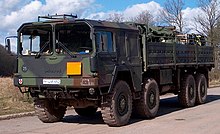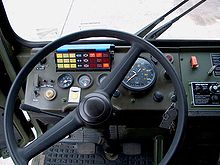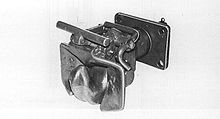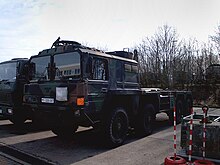MAN gl

1. FeldArtLBtl 51 Idar-Oberstein
The MAN gl or MAN mil gl is a special military development of an all-terrain truck for the Bundeswehr .
history
In 1962, the Bundeswehr planned to replace its vehicle fleet from the construction period. Two-, three- and four-axle land vehicles in the payload class 4 to 10 tons with buoyancy were required . Due to the high proportion of new developments, the Federal Office for Defense Technology and Procurement (BWB) was unable to take on technical responsibility for a decision and recommended that the participating companies establish a joint office (GB) and agree on a project.
Two years later, in 1964, the joint office of the German commercial vehicle industry was formed under the leadership of MAN . The manufacturers Klöckner-Humboldt-Deutz (KHD) , Büssing , Krupp and Henschel were also involved in the project.
On August 12, 1964, the BWB created the requirements for the second generation. The specifications for the so-called next generation were largely commercial vehicles, unrestricted off-road mobility, buoyant, permanent all-wheel drive, low-pressure tires with emergency running properties, steel cab, ABC tightness, multi-fuel engine and a service life of at least ten years.
Due to the high procurement costs and the new NATO standard, swimming, ABC and multi-fuel capabilities as well as the low-pressure tires were canceled and a new requirement was defined. The payload for the two-axle vehicle was increased to 5 t, the fording depth was set to 1200 mm, the loading area height was raised to 1650 mm, air-cooled Deutz V8 engines with and without turbocharging and tires with a size of 14.00 R 20 were specified. This “slimmed-down” variant was still too expensive to be introduced across the board. After further testing, the project was divided into standard commercial vehicles and special military developments and, depending on the off-road capability, into six categories.
On December 4, 1975, the German Armed Forces signed a series contract with MAN for the delivery of the special military developments, which were now divided into two categories. On November 29, 1976, the first category I-MAN, the 10 t mil gl.
General
MAN series, introduced under the name mil gl (for mil itarisiert g e l ändegängig), located in all branches of the armed forces of the Bundeswehr in use. The militarization includes a camouflaged light circuit separate from the normal lighting (camouflaged light headlights in front, camouflaged rear and brake lights as well as the guide cross ), military arrangement of the instrumentation with the possibility of camouflage, an emergency stop switch for switching off the power supply, a roof hatch with rotating ring mount and rifle mounts. The vehicles belong to Category I (KAT I) of special military developments and are therefore fully off-road. The vehicles of the payload class 5 t, 7 t, 10 t KAT I belong to the second generation (next generation) and with the identifier KAT I A1 belong to the extended next generation, including the 15 t version. Vehicles of the KAT-I generation underwent major overhauls in the mid-1990s in order to extend their service life by another ten years.
Vehicles in category I A1.1 (KAT I A1.1) such as the 15 t mil gl “ Multi ” belong to the so-called third generation and are further developments, but still belong to the special military developments.
Often the vehicles are known under the term “5-, 7-, 10-, 15-tonner”, this denotes the military payload class (corresponds to the maximum payload and should not be confused with the military load class ). “Tonner” refers to the payload in the colloquial language of the Bundeswehr.
technical structure
All trucks in the series are built in a modular system. All vehicles consist of an extremely torsion-resistant ladder frame with closed box side members and tubular cross members welded to them, equipped with highly movable axles guided on handlebars, which are connected to the frame via coil springs. The engine sits in the forward control cab, which is divided into the driver's and engine compartments by a partition. As a special feature, the engine is installed behind the driver's compartment and not underneath, as is the case with other front control vehicles. This made it possible to achieve a height of almost 2.9 m above the driver's cab, which enables loading onto standard railroad cars. In order to comply with the loading gauge of the railroad, the upper side edges of the driver's cab were characteristic beveled. Since the vehicles of the first series are still based on the floating prototypes, their cab cannot be tilted for maintenance purposes. This was only introduced with the second series in the mid-1980s. The engine delivers its power to the front and rear axle (s) via the converter clutch , manual transmission and the transfer case. In the first KAT I series, these three components form a unit and are therefore a special component. For the later KAT I A1 series, cheaper mass-produced parts from ongoing truck production are used. This also allowed the number of gears to be increased from 6 to 16, which increases the theoretical top speed from 90 to around 130 km / h. At the usual speed of 80 km / h, the engine speed is reduced considerably, which lowers fuel consumption. The on-board voltage is 24 V and thus corresponds to the standard in the Bundeswehr. A special feature is the trailer hitch . In contrast to a civilian vehicle, the MAN mil gl, like every Bundeswehr truck, has a hook coupling (also called “NATO coupling”). This enables trailer operation even in difficult terrain, but requires the use of trailers with a suitable towing eye. Since the MAN mil gl already has the newer, automatically locking version of the hook coupling, it can continue to be used without restrictions if the vehicle is registered for civilian use, provided the trailer is equipped with a corresponding towing eye.
For self-defense, the vehicles have an MG3 machine gun mounted on a rotating ring mount .
As part of the Bundeswehr's foreign missions , some vehicles were additionally armored with modular protective equipment (MSA) in order to increase the protection of the crew. Generation 3 new builds, on the other hand, have so-called vehicle protection equipment (FSA), depending on the model. In contrast to MSA, as with the ATF Dingo , the vehicles receive a protective cell during production and are accordingly matched to it.
Variants (2nd generation)
Truck 5 t mil gl KAT I and KAT I A1 (4 × 4)
Driven by a Deutz V8 diesel engine F8L413F with 256 hp , two variants (types 451, 461) were introduced from 1976 to 1985. These vehicles were mainly used as flatbed trucks with and without tarpaulin for the transport of people and materials, as a carrier vehicle for cabin II, as a carrier for the fire control radar (FERA) of the light artillery rocket system (LARS) and as a recovery vehicle with a 1-tonne crane Atlas-Weyhausen company for the KZO “Brevel” small aircraft .
The tank trucks based on the 5 t mil gl are a specialty . Due to the tank attachment (TA) with pump in the configuration 4600 l and 2 × 2300 l, the vehicles exceed the permissible total weight by one ton. Based on tests and with the approval of the tire manufacturer, the tire pressure was increased to compensate for this. All vehicles also have a special permit.
In contrast to the 451, the type 461 trucks are equipped with a 30-meter cable winch from Rotzler and also have a small “w” in their name, the designation then reads 5 t mil glw . The tensile load of the cable winch is 5 t and the cable can be laid forwards or backwards. The 2073 vehicles with winches went almost exclusively to the army .
In the years 1986 to 1993, the Air Force commissioned further vehicles under the condition that they could be transported by air in a C-130 Hercules or C-160 Transall . In these trucks, which were introduced with the designation KAT I A1, defects in the first version were eliminated and slight changes were made. So the fixed cab was modified to speed up the engine change. The driver's cab has a removable hardtop for air loading .
5 t gl KAT I with tarpaulin and bow
Truck 7 t mil gl KAT I and KAT I A1 (6 × 6)
The trucks with a payload of 7 t are the second vehicle in the second generation of the MAN family. Driven by a more powerful, air-cooled 320 HP Deutz engine with exhaust gas turbocharger and intercooler , they have the same structure as the 5 ton truck. The second rear axle is driven by a through drive on the first rear axle.
In total, MAN produced five types in the KAT-I version between 1977 and 1985. Types 452, 462 with winch and 463 were used as flatbed vehicles, equipment carriers for the reconnaissance drone CL289 , as equipment carriers for the light artillery rocket system (LARS) and, in the case of the pioneer units , as a traction device for the mine-laying machine 85 (MiV85) and the three-axle flatbed trailer 15 t. In the 453 version, MAN built a three-way tipper with a cable winch for the pioneers and a container transport vehicle for the paramedics. The last type of the next generation was a device carrier for the folding swimming bridges . Equipped with a flat bed and an extended wheelbase, this type 455 can carry all parts of the bridge and the motorboat 3. Like the Type 462, this vehicle has a 5 ton cable winch.
In total, MAN produced 3500 vehicles in the 7-ton class in the CAT I version.
As with the 5-ton truck, the Air Force again announced a need at the beginning of the 1980s. From 1986 to 1993 MAN delivered vehicles in the improved KAT-I-A1 version for the Patriot anti-aircraft missile system. In addition to the function as a carrier vehicle for the fire control and combat control system, the 2 × 150 kW power generation system and the antenna mast group were also loaded onto the truck.
MAN 7 t gl KAT I: THW model retrofitted with a loading crane and light metal bars
Multiple rocket launcher 110 SF, on MAN 7 t mil gl ( LARS 2 )
Launch vehicle M21 (MAN 7 t mil gl ( CL289 ))
Truck 10 t mil gl KAT I (8 × 8)
The four-axle truck completes the KAT-I family. Equipped with a 320 HP Deutz engine, exhaust gas turbocharger and charge air cooling, this truck is used by the supply units of the divisions , brigades and corps units of the army. Due to the extended loading area, this vehicle is used to transport bulk consumer goods such as ammunition and fuel and is used to supply the combat units. MAN built two versions between 1976 and 1985. Type 454 only had a 5-ton winch from Rotzler and was dependent on handling equipment such as forklifts. In contrast, the type 464 had a 1-ton loading crane from Atlas-Weyhausen , mounted on the left side of the center of the shop space. Due to the loading crane, this type can only load nine instead of ten Euro pallets .
Extended 1-ton loading crane from Atlas-Weyhausen
Based on the 10 t mil gl and glw , the trucks of the extended next generation KAT I A1 and the next generation 3 such as the MULTI swap body system were developed.
Truck 15 t mil gl KAT I A1 (8 × 8)
At the beginning of the 1980s, MAN delivered improved vehicles of the KAT-I-A1 version as carrier vehicles of the 15 t class to the Air Force. With a track width enlarged to 2900 mm, these vehicles with the designation 15 t mil gl BR A1 serve as equipment carriers and launch systems for the Roland and Patriot weapon systems . A conventional chassis with a flatbed superstructure is used as the guided missile transporter, which has been expanded to include a 2.5 t slewing crane from Atlas .
The four-axle truck is powered by a Deutz 8-cylinder diesel engine with 360 hp, an exhaust gas turbocharger and a charge air cooler. Like the 5-, 7- and 10-tonne trucks, some of them have a Rotzler winch.
The COBRA artillery location radar , introduced in 2006, also uses chassis of the KAT-I-A1 generation that have become vacant.
3rd generation
Generation 3 vehicles are further developments of the MAN-gl family and belong to the Bundeswehr transport and special vehicles concept . They belong to category I and meet the newly defined mobility level A. This requires unrestricted cross-country mobility on heavy and damp soils, the ability to follow the combat vehicles and a fording depth of 1.20 m. Civil they carry the designation SX (highly off-road, screw-sprung) and HX (partially off-road, leaf-sprung).
As with Generation 2 vehicles, they are built according to the modular system. In order to save costs, parts of the predecessor were used and improved, but new developments were also installed. Modifications were made to the cab and the braking system was improved with the addition of a retarder .
The vehicles are procured from the Bundeswehr on an order-related basis and not, as planned, by exchanging “old for new”.
variants
Generation 3 was procured from the German Armed Forces in payload classes 7 t and 15 t. Both vehicles are powered by a six-cylinder engine with 400 HP of the type MAN D 2866 LF in the emission classes Euro 1 or 2. The seven-ton truck serves as a carrier vehicle for the AUTOFUE radio relay of the Air Force's FM intelligence service, as a carrier vehicle for the radio relay systems of the HAWK air defense system and as a Air-transportable variant of the Roland weapon system . The vehicles in the 15 t class are used as recovery and towing vehicles (BKF 30.40), the MULTI swap body system and as laying and transporting the folding fixed bridge. A well drilling rig for the pioneers of the Bundeswehr, which was also planned on this chassis, was not introduced. The prototype went to the Netherlands .
SX series
The SX is the latest development stage of the original MAN gl. The most important features are still the extremely torsion-resistant ladder frame with closed box side members and thus welded tubular cross members, as well as the particularly movable chassis with axles guided on handlebars and long-stroke coil springs.
On request, the 8 × 8 can also be supplied with hydropneumatic suspension on the rear axles ("Heplex"). The SX has a wider frame track compared to civilian trucks, as only axles with single tires are intended. The MAN D20 engine with 440 hp sits under the tilting cab between the first and second axles, and the radiator lies flat above it. The spare wheel is installed lengthways to the side behind the cabin. All SX models are also available with a driver's cab protected in accordance with STANAG 4569 and are mostly used as a system carrier for special bodies (e.g. box bodies) that require a high level of assertiveness in the field and a torsion-resistant frame.
The current representatives of the SX series are:
- MAN SX 25.440 6 × 6 (MAN type designation X44) e.g. B. as antenna mast transporter (antenna mast carrier), tanker or container transporter
- MAN SX 32.440 8 × 8 (X45) e.g. B. as recovery vehicle (recovery vehicle), bridge layer (bridge layer) or with load handling system (swap loading bridge)
The MULTI 2 FSA is also a structure based on the MAN SX. In addition, the SX series is also the base vehicle for many civil airfield fire engines , expedition vehicles and special military vehicles such as the carrier vehicle for the Panzir or Patriot anti-aircraft missile system.
HX series
The MAN HX series is technically very different from the current SX series and its predecessors. The ladder frame in C-profile design is based on that of the civil TGA series. Due to the use of leaf springs, the mobility of the axes is at a slightly lower level than with the SX with coil springs. The motor is located under the cab at the height of the first axle and thereby shifts the center of gravity further forward compared to the SX. All HX models are also available with a protected driver's cab and are mostly used in a configuration for classic transport tasks. Typical representatives of the HX series are:
- MAN HX 18.330 BB 4 × 4 (MAN type designation X60) as "Cargo" or "Troop Carrier"
- MAN HX 25.440 BB 6 × 6 (X58) as "Cargo", "Troop Carrier", "Tanker" or "Tractor" (tractor unit)
- MAN HX 32.440 BB 8 × 8 (X77) as "Load Handling System" (interchangeable loading bridge)
- MAN HX 44.680 BBS 8 × 8 (X81) as "Tank Transporter" (tank transporter) or "Recovery" (recovery vehicle)
Optical distinguishing features to the SX are the radiator, which is mounted lengthways on the left side of the vehicle, and the spare wheel installed across. With the exception of the X81, all HX and SX vehicles are powered by MAN in-line six-cylinder engines.
The X81 is special as it is equipped with the 680 hp MAN D2868 V8 engine. As the only representative of the HX series, it has an additional cooler on the right-hand side of the vehicle.
Users



In addition to the Bundeswehr and the German Technical Relief Organization (THW), other armed forces, organizations and states use the MAN gl in various versions. The British armed forces use HX and SX variants in the payload class from 5 to 15 tons. Other users of the family are the armed forces of Luxembourg , Estonia and Greece and, under the name ÖAF (" S-LKW "), the Austrian Armed Forces .
After being taken out of service by the Bundeswehr, numerous KAT-1 vehicles are now also used in the civilian sector, for example as expedition vehicles / mobile homes for extreme conditions.
US Army Pershing II transporter
For the Pershing II medium-range missiles to be stationed by the American armed forces in Baden-Württemberg and Bavaria and deployed from different locations in Europe , MAN developed the tractors on the basis of the MAN gl. The Bundeswehr's KAT I concept initially served as the basis, However, this was rejected by the USA as insufficient. MAN then modified the vehicles and installed a water-cooled V10 engine , larger 16.00-inch tires and an engine tunnel including a radiator grille. The modified vehicles were given the designation "KAT 2" by MAN, which, however, has nothing to do with the classification of the German armed forces.
literature
- Peter Ocker: MAN. The all-wheel drive all-rounder. Development. Technology. Commitment. Heel, ISBN 3-89365-705-3
- Lutz-Reiner Gau, Jürgen Plate, Jörg Siegert : German military vehicles. Bundeswehr and NVA. Motorbuchverlag, Stuttgart 2001, ISBN 3-613-02152-8 .
- Dietrich Fuchs: Calculation and comparison of different construction principles for ladder frames of commercial vehicles with torsional stress. Munich, TU, F. f. Mechanical engineering and Electrical engineering, diss. V. May 18, 1972.
Web links
- www.deutschesheer.de Bundeswehr> Army> Technology> Wheeled vehicles> Truck 10t mil gl
- All-terrain truck ÖAF in the armed forces















